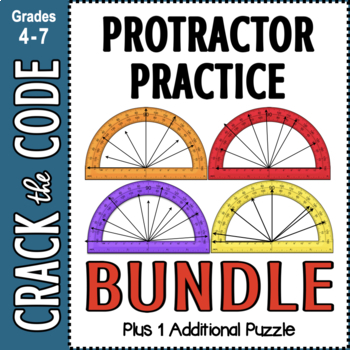Protractor Practice - Crack the Code Math Activities BUNDLED
- Zip
Products in this Bundle (4)
Bonus
Also included in
- Math Practice Activities Crack the Code Super Bundle for grades 5-7 includes over 40 Crack the Code self-checking puzzles practicing a variety of math skills. Many of the selections are differentiated so that all ability levels are challenged. These engaging activities are loaded with mental mathPrice $52.25Original Price $67.25Save $15.00
Description
Protractor Practice-Crack the Code BUNDLED! is the perfect way to give your class that much needed practice reading protractors. In addition to the four separate resources listed below, this bundle also includes an additional puzzle, available here only.
9-2018 Update! The original puzzles now also include a metric measurement option for those of you that are metric measurements only.
These fun activities are loaded with mental math and problem solving opportunities, as well as additional extensions that challenge students to organize their thinking.
Enjoy a bonus puzzle, only available in this bundle!
• Os & 5s
• Protractor Practice With Supplementary & Complementary Angles - Crack the Code
Please Note: These activities are designed to give students practice reading angles, not measuring them with real protractors. They need to use the protractor provided, and devise a way to extend the rays that do not touch that protractor. The problem solving has them adding and subtracting to find the measurements, using what they know about acute and obtuse angles.
Each Protractor Practice activity has several rays all starting in the same place, which muddies the point of origin, leading to inaccurate measurements, if students try to use a real protractor.
Ways to use Crack the Code puzzles~
- Centers
- Go-to Activities
- Fun Class Challenge
- Small Group Challenges
- Paired Work (Buddy up!)
- Test Prep
- Homework
- Sub Days
- RTI
Click HERE for additional Crack the Code puzzles.
***************************************************************************
Customer Tips:
How to get TpT credit to use on future purchases:
Please go to your My Purchases page (you may need to login). Beside each purchase you’ll see a Provide Feedback button. Simply click it and you will be taken to a page where you can give a quick rating and leave a short comment for the product. Each time you give feedback, TpT gives you feedback credits that you use to lower the cost of your future purchases. I value your feedback greatly, as it helps me determine which products are most valuable for your classroom, so I can create more for you.
Be the first to know about my new discounts, freebies and product launches:
Look for the green star next to my store logo and click it to become a follower. Voila! You will now receive email updates about this store!
Thanks for stopping by! Pam Kranz
***************************************************************************
© Pamela Kranz Desktop Learning Adventures All Rights Reserved






